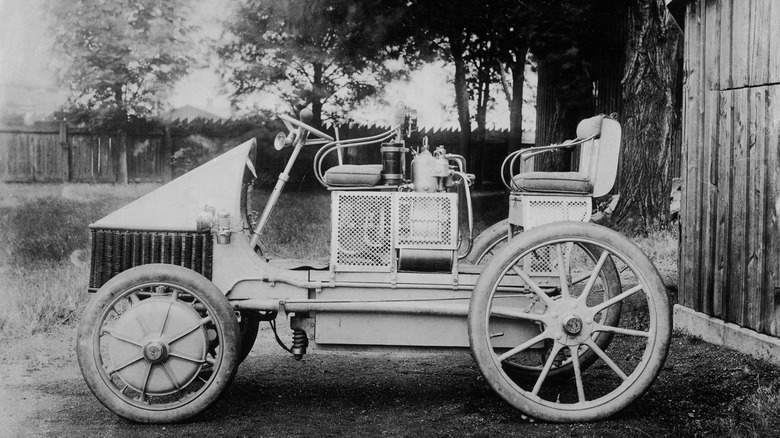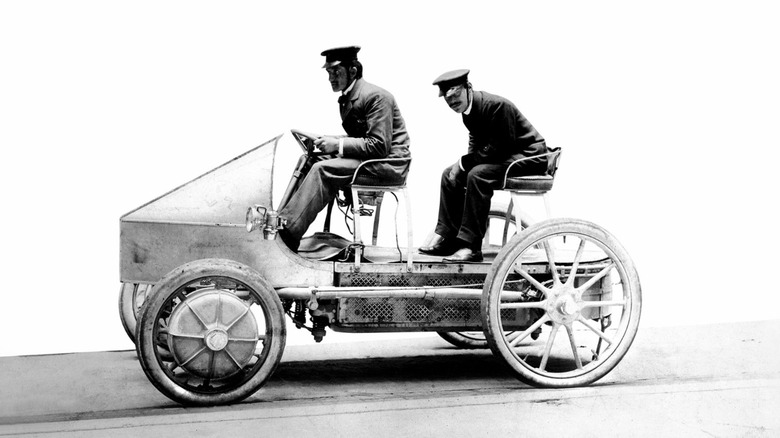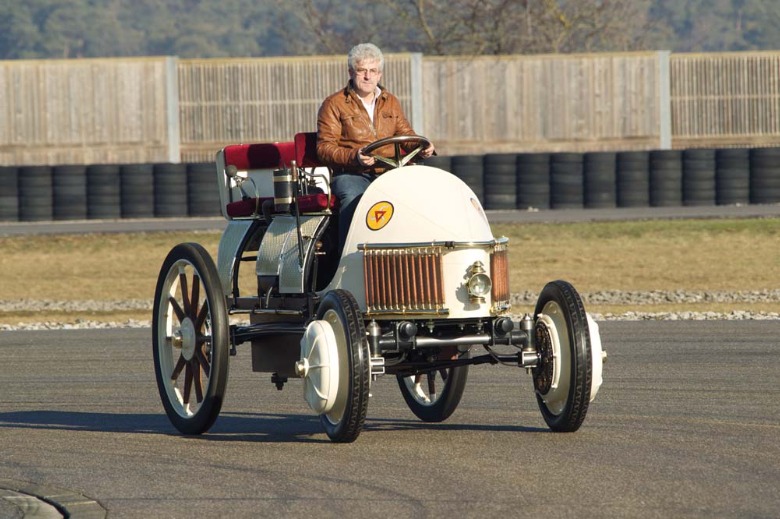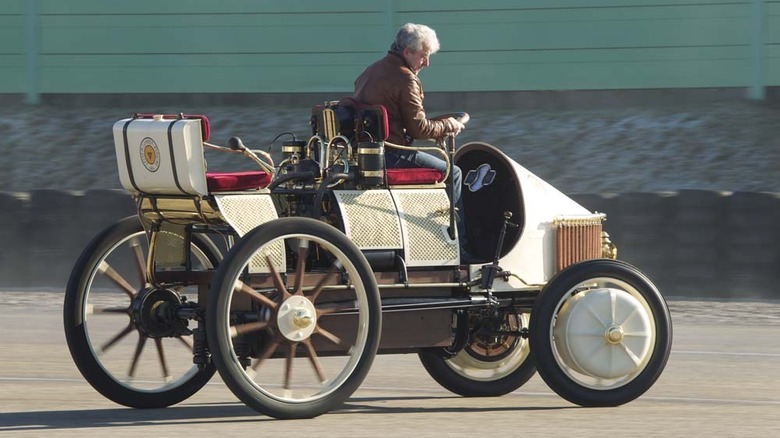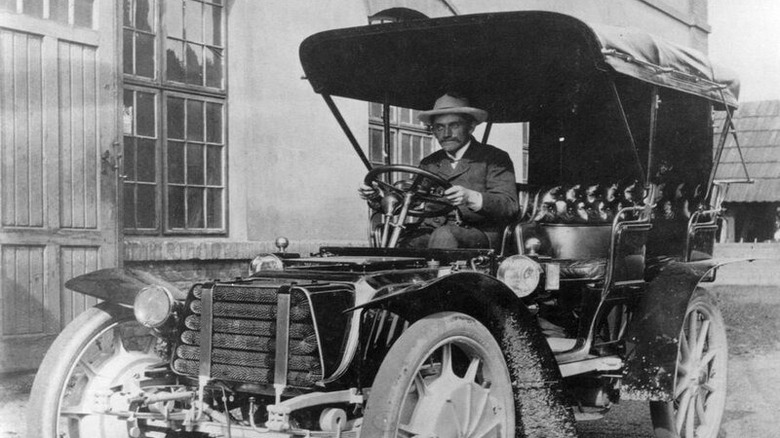Porsche Built A Hybrid In 1900 That You've Probably Never Seen
Japanese automakers Honda and Toyota are widely credited for headling the modernization and mass-market acceptance of hybrid-electric vehicles. The first-gen Honda Insight two-door coupe arrived in 1999 to become the first mass-produced hybrid vehicle for sale in the USA, and the Toyota Prius sedan followed suit in 2000. But before Japanese automakers gained a foothold in the modern hybrid-electric vehicle (HEV) market, there was a young German engineer that created the world's first functional hybrid car in 1900.
Modern electric vehicles can trace their lineages from 1886, and it's not unusual to see cars powered by steam, gasoline, or electricity during the early 1900s. Early versions of electric vehicles were quieter, safer, and smoother to operate than equivalent gas or steam-powered conveyances, but they were not without compromises. Vintage EVs required heavy batteries and costly charging infrastructures. At the same time, the driving range was subpar at the most, and these same issues still plague humanity's transition from fossil fuel to electrons.
In 1900, a 25-year-old Ferdinand Porsche came up with the Semper Vivus, the world's first functional hybrid car. The Semper Vivus (Latin for Always Alive) was unlike any other vehicle and took the 1901 Paris Motor Show by surprise.
Ferdinand Porsche: Father of the hybrid car
Porsche's Semper Vivus can trace its roots to the Egger-Lohner C.2 Phaeton electric car of 1898. It had an octagonal electric motor churning out five horsepower and reached a top speed of about 15.5 mph (25 kph). Porsche joined Vienna-based carriage-maker Hoofwagenfabrik Ludwik Lohner & Co. in 1899. He caught the attention of company founder Ludwig Lohner as Porsche envisioned a front-wheel-drive wheel-mounted electric motor. This innovative design eliminates installing a separate transmission and differential to turn the wheels, and Lohner had the means and industrial might to make it a reality.
The first-ever Lohner-Porsche Electromobile debuted at the 1900 Expo in Paris with a pair of 2.5-horsepower electric motors and a 23 mph (27 kph) top speed. Shortly after, Porsche came up with the Semper Vivus, an updated version with a new Lohner-Porsche range extender. It was essentially an electric car with batteries, but it also had a gasoline engine that spun a generator to recharge said batteries. Forward and reverse thrust remained courtesy of Porsche's genius hub-mounted electric motors — the gas engine did not turn the driving wheels. As long as there was fuel in the tank, the Semper Vivus was "always alive" and would achieve a virtually unlimited driving range.
Lohner-Porsche Semper Vivus: The world's first series hybrid electric vehicle
Riding on an EV chassis that Porsche utilized at the Semmering-Bergrennen race, Semper Vivus had a pair of single-cylinder De Dion-Bouton gas engines behind the driver's bench seat, according to Hemmings. Each could either spin the generator (and provide electricity to power the wheel hub motors) or drive a water pump to cool the gas engines. The vehicle also had 44 battery cells to reduce weight (the electric-only Electromobile had 74 battery cells), but Semper Vivus still tipped the scales at about 2,640 pounds (1200 kgs) despite not having doors, a roof, or rear suspension. Each gas engine and generator could produce 90 volts and 20 amperes, and energy not required by the motors went to an accumulator for future use.
The Semper Vivus debuted in 1901 at the Paris Motor Show, and we can only imagine the number of jaws that dropped as people first laid eyes on the world's first hybrid car. Production of the Semper Vivus and other iterations continued until 1915 but didn't sell well despite several improvements to the car's basic design. It had no rear axle or rear suspension which gave it the ride quality of a horse-drawn carriage, according to The Drive. It offered seating room for up to five adults, but the smoke, oil, and fumes from the vehicle's gas engines and generators made it hard to enjoy.
Lohner-Porsche Mixte
Porsche made an improved version of the Semper Vivus called the Porsche-Lohner Mixte. Instead of having a pair of gas engines, the Mixte had a single 5.5-liter Daimler gas engine in front of the vehicle like a conventional car, now pumping out 25 horsepower and running at a constant speed to power the generator. It also had an electric starter and a single shaft-driven generator under the driver's bench seat, but it still failed to capture the world's imagination. The final nail in the coffin is the astronomical price tag. The Lohner-Porsche started at 14,400 to 34,028 Austrian Krone, equivalent to about $2,900 to $6,800 in 1901. According to Official Data Foundation's In2013Dollars calculator, $2,900 in 1901 is roughly equivalent to over $98,000 in 2022.
The funny thing about this story is the driving force behind Lohner's belief in producing a gas-electric hybrid car. Lohner and Company never recouped their investment and probably lost a ton of money on Semper Vivus. Still, it didn't stop them from addressing the issue of clean air "ruthlessly spoiled by a large number of petrol engines in use," an environmental problem that persists to this day.
